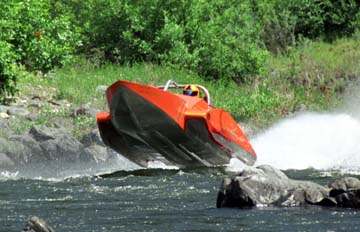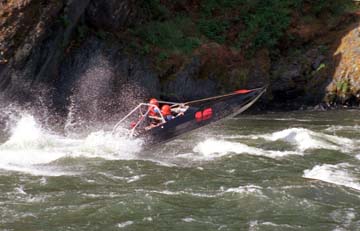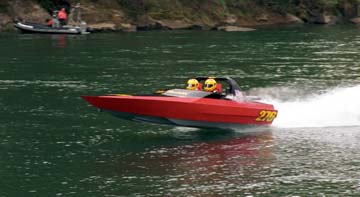Brief anatomy of a whitewater race boatALL of the hulls these days are aluminum. Other materials are allowed by the rules, but aluminum is used exclusively. One of the last boats other than aluminum was a wood boat raced by Hugh McGinnis in D-class in the late eighties. I've also heard that there was one other boat, run by Dale Williams from St. Louis Missouri and Paul Rigney from Grand Rapids
Michigan. They teamed up and brought a Glastron CVX 20 to the Worlds' in Lewiston
in '92. There was some concern from their competition for their safety. Trying to get some more info on this...The predominate hull is designed and manufactured by Eagle Racing. Eagle Racing is Rob Chrunyk and crew from Sylvan Lake, Alberta, Canada. Go here for more information and great media.
Eagle is the number one race hull but there are others racing. Kwikraft is a New Zealand hull designed and built by Tony Ward, 19 to 21 foot tunnel. There also is at least one Doug Riddle hull still racing and there are several unique one-offs, the two built by River Wild are good examples. One is a 21 foot B-class tunnel and the other is an 18 foot FX class tunnel.
Bottoms are anywhere from .160 to 3/16ths. Sometimes AR plating is used as an extra layer of protection. Sides are generally .090, decks can be even less than that. Saving weight is very important and the location of the weight in the boat is even more important. Most use spoons, an add on piece in front of the intake. Hulls are generally tunnels although v-hulls have done well in FX class, and River Wild has built two super light "semi-wing in ground effect" hulls that are also quite good. The FX version did especially good in 2001. I believe the Eagle 19 foot Sport step-tech will become a big force in FX class in the next few years.

Derek Ely's River Wild FX hull. Narrow hull with stubby high chord wings with tip plates/sponsons. Extremely light construction.
A Kwikraft hull. Big, heavy, tough.
An Eagle Racing 21 foot tunnel, newest design. Very fast, very nimble.Since these boats are raced through whitewater interspersed with rocks and logs, they need to have fairly precise handling characteristics compared to other types of race boats. They also need to be very predictable. Bad habits and quirks can put you up in the rocks or worse.
The pumps are obvously highly modified, but based on Berkeley, Legend, Aggressor or American Turbine production pumps. Stainless impellers are almost universal. Full rock grates, although again highly modified, are also universal. On the higher powered boats much attention is applied to supplying the thrust bearing with lots of clean lube. Various methods are used for this including pumps and pressure lube systems.
-pic-
Fabricated steel nozzles are used almost exclusively, and various combinations of wedges. The nozzle replaces the entire piece from the bowl back.
-pic-
It's probably obvious, but maybe it needs stating, the black art of this racing is the pumps and the hulls.
The engines are pretty straight forward. They have to make good horsepower and torque at less than about 6500 rpm, but they have to be able to do this fully loaded down at full throttle for up to 30 minutes. They have to be able to do this reliably at least twice a day (sometimes more) and for two days in a row. That's the minimum requirement to finish and you know the saying, "to finish first, first you have to finish". Rumour has it, and it's only rumour that I've heard, that some of the unlimited engines are over 650 cubic inches!
Engines and pumps are set way back, most of the pump hangs out the back of the boat. Fuel tanks sizes range from 25 to 35 gallons for an FX boat to 60 to 100 gallons for an Unlimited boat. Usually they are set up as saddle tanks, at the very back of the hull.
-pic-
Most boats have run rollbars in the past and it is now a requirement. Most are made out of aluminum and have double or triple hoops with back braces. Perhaps we may see a move towards chrome moly construction as the anchoring and hoop requirements begin to make them a good tradeoff weightwise.
-pic-
Five point harnesses with lever locks are also a requirement, not to mention a good idea. Race type lifejackets from Lifeline and Security are also used as are fire suits.
All boats carry first aid kits, fire extinguishers, two ropes, paddles, tools, some minor spares and a red flag.
What have I missed? What do you want to know? Drop me a line- Jesse